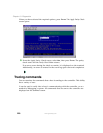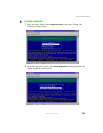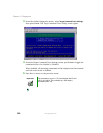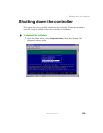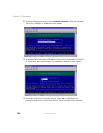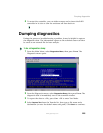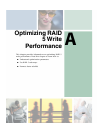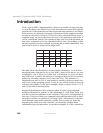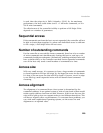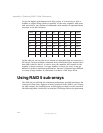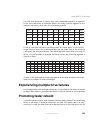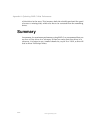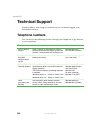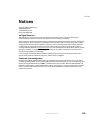
228
Appendix A: Optimizing RAID 5 Write Performance
www.gateway.com
Introduction
With a typical RAID 5 implementation, there are a number of steps necessary
to write the data to the media. Every write from the host system will typically
generate two XOR operations and their associated data transfers to two drives.
If the accesses are sequential, the parity information will be updated a number
of times in succession. However, if the host writes sufficient data to cover a
complete stripe, the parity data does not need to be updated for each write. It
can be recalculated instead. This operation takes only one XOR operation per
host write, compared to two for a standard RAID 5 write. The number of data
transfers necessary are also reduced, increasing the available bandwidth. This
type of write access is termed a Full Stripe Write.
The table shows the distribution of data chunks (denoted by Cx) and their
associated parity (denoted by P(y-z)) in a RAID 5 array of five drives. An array
is defined as a set of drives, on which data is distributed. An array will have
one RAID level. A chunk is the amount of contiguous data stored on one drive
before the controller switches over to the next drive. This parameter is
adjustable from 64 K to 256 K, and should be carefully chosen to match the
access sizes of the operating system. A stripe is a set of disk chunks in an array
with the same address. In the above example, Stripe 0 consists of C0, C1, C2,
and C3 and their associated parity.
Maximum performance will be achieved when all drives are performing
multiple commands in parallel. To take advantage of a Full Stripe Write, the
host has to send enough data to the controller. This can be accomplished in
two ways. If the host sends one command with sufficient data to fill a stripe,
then the controller can perform a Full Stripe Write. Alternatively, if the host
sends multiple sequential commands, smaller than a stripe size (typically
matching the chunk size), the controller can internally combine these
commands to get the same effect. In the above example, if a 256 K chunk size
P (20-23) C20 C21 C22 C23 Stripe 5
P (16-19)C17 C18 C19 Stripe 4
P (12-15)C13 C14 C15 Stripe 3
P (8-11)C9 C10 C11 Stripe 2
P (4-7)
C16
C12
C8
C4 C5 C6 C7 Stripe 1
P (0-3) C0 C1 C2 C3 Stripe 0



